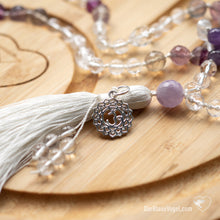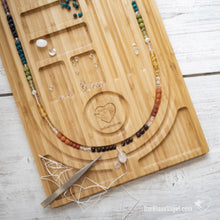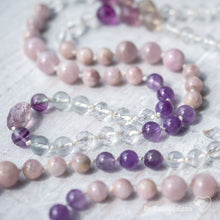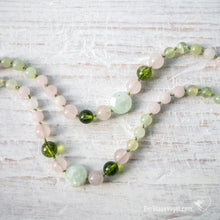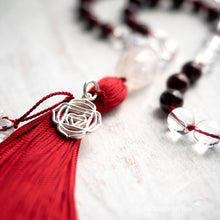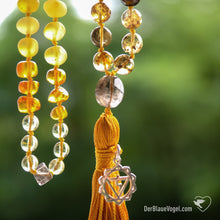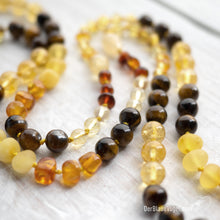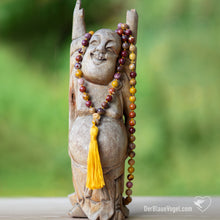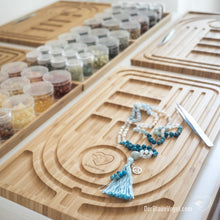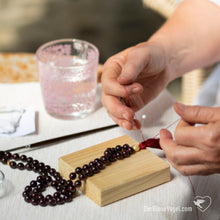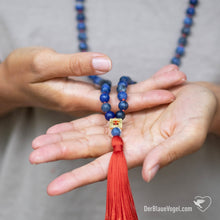
Knüpfe deine eigene Chakra Mala | Von Muladhara bis Sahasraha.
Alle DIY Kurse || Malas | Perlenbretter | Blog
Chakren sind die Energiezentren in unserem Körper. Dei 7 Hauptchakren sind vielen grundsätzlich bekannt, aber selten, wie sehr man diese durch einfache Meditationen stärken und wieder besser in die Balance bringen kann. Die Japa Meditation ist eine Art der Meditation, bei der Mantren (meist vedische Verse) in einem beruhigenden Rhythmus wiederholt (rezitierend) gesungen werden. Das muss nicht zwangsweise laut geschehen, sondern kann auch in jeder Lebenslage leise in Gedanken ausgeübt werden. Die gesungene Form bietet allerdings den Vorteil, dass sich die im Körper ausbreitenden Vibrationen, die man selber durch das Singen automatisch erzeugt, wie eine kleine Klangtherapie wirken. Wir reagieren auf Schwingungen und unsere Energiezentren werden dadurch nachweislich stimuliert und beruhigt. Jedes Chakra hat einen eigenen Laut, der wiederholt gesungen werden kann - entweder speziell für ein Chakra, oder nacheinanderfolgend für alle Chakren.
Beim Rezitieren von Mantren werden in der Japa-Meditation oft Malas eingesetzt. Sie sind sozusagen die Rosenkränze der Yogis und dienen als "Zählhilfe". Dabei wird eigentlich nicht aktiv bewusst gezählt, sondern man schiebt die Mala Kette Perle für Perle nach jeder Wiederholung weiter und weiß durch die integrierten Markierungen (Marker-Perlen oder Spacer) wann man eine gewisse Anzahl an Wiederholungen erreicht hat. Benutzt werden dabei je nach Tradition meist der Ring- und Mittelfinger. laut meinem Yogalehrer Peter Clifford aus dem Grund, weil der Mittelfinger das Element Akasha (Äther, Himmel) repräsentiert und der Ringfinger das Element Erde. Wir als Menschen, stehen für die Regenbogenbrücke zwischen Himmel und Erde. Aus diesem Grund verbinden wir uns während des Rezitierens der Mantran, indem wir die Mala zwischen diesen beiden Fingern weiter gleiten lassen. Ich finde diese Erklärung eingängig und schön, deshalb habe ich sie übernommen. Andere Traditionen benutzen die Mala mit anderen Fingern - das kann ich respektieren und überlasse es jedem selbst, wie er sie benutzt.
Die Finger fühlen während der Benutzung der Mala den Unterschied in der Größe der Perlen. Traditionell wird im Yoga alles 108 mal wiederholt. Die 108 ist die heilige Zahl der Yogis und hat viele Bedeutungen. Es können aber auch weniger Wiederholungen ausgeführt werden, solange diese durch neun teilbar sind. Dabei gelten die Schritte 9, 27, und 54 als die üblichen. Das macht nicht nur bei besonders langen Mantren Sinn, sondern auch bei anstrengenderen Asanas, die ein Anfänger Yogi keinesfalls 108 mal ausüben kann und sollte.
Mala-Ketten werden aber nicht traditionell beim Rezitieren von Mantren verwendet, sondern werden heutzutage auch gerne als besondere Schmuckstücke getragen. Dabei werden die traditionellen Rudraksha Perlen, (die eigentlich die Samen eines Baumes sind) durch unterschiedliche Perlen aus vielerlei Materialien ersetzt. Das können Natursteinperlen sein, Holzperlen aber auch hochwertige Edelsteinperlen. Die Anzahl der Perlen bleibt dabei meist bei 108. Natürlich gibt es auch hier Spielräume. Zum Beispiel gibt es Armband-Malas mit 27 Perlen, doppelte Malas mit 216 Perlen, halbe Malas mit 54 und so weiter. Auch die traditionelle Quaste, in der eigentlich die Schnur (in modernen Malas Perlseide oder Nylongarn), auf der die 108 Perlen mit 109 Knoten befestigt sind und die dann durch eine sogenannte Guruperle geführt, endet, nicht selten durch einen Anhänger ersetzt. Auch Quasten, die nicht mit 108 Fäden gewickelt, sonder nur aus zwei Enden mit je drei Perlen bestehen, haben einen traditionellen Ursprung.
Eine Mala besteht in der Regel aus 108 Perlen sowie einer Guru-Perle. Im Buddhismus sowie im Hinduismus hat diese Zahl eine besondere Bedeutung. Es heisst, dass ein Mantra erst nach 108 Wiederholungen seine besondere Wirkung entfaltet.
Dieser fünf-stündige Workshop bietet die Möglichkeit, aus über 70 verschiedenen Halbedelsteinen, Natursteinen und Holzperlen Heilsteinen auszuwählen und sich seine ganz eigene persönliche Mala zusammenzustellen. Diese individuelle Yoga-Malakette wird dann von den Teilnehmern unter Anleitung selbst geknüpft und mit einer selbst gefertigten Quaste aus Seide oder alternativen Materialien versehen.
Im Anschluss gibt es eine kleine gemeinsame Chakra Mediation im angeschlossenen Yogaraum, bei der die eigene Mala für die persönliche Japa-Mediation eingeweiht wird.

Beispiel für eine Manipura (Solar plexus) Chakra Mala. Dieses Chakra repräsentiert das Element Feuer. Wenn es aus der Balance gerät, kann dies zu angestauter Aggression und Verdauungsstörungen führen. Im ayurvedischen Lehre steht das Agni für unser Verdauungsfeuer. Dieses Chakra ist bei vielen Menschen heutzutage aus der Balance. Ursachen dafür liegen nicht nur oft in der Ernährung, sondern auch in unserer schnellebigen Gesellschaft, in der wir uns kaum mehr Zeit nehmen, etwas "zu verdauen" und übermäßiger Konsum an der Tagesordnung ist. Die Farbe dieses Chakras ist Gelb und die zugeordneten Steine, die dieses Chakra stärken sind zum Beispiel Citrin, aber auch Bernstein oder das Tigerauge. Alle diese Steine und viele weitere stehen für diesen Workshop als Auswahl zur Verfügung.

Das Anahata (Herz) Chakra liegt mir persönlich (im wahrsten Sinne des Wortes) sehr am Herzen. Bin ich doch auch Anahata Yoga-Lehrerin und somit bestrebt meine Mitmenschen und Schüler darin zu unterstützen, die Kunst der Selbstliebe mit offenem Herzen für sich selbst und allen anderen Menschen zu lehren. Dazu gehört laut meinem Lehrer Peter Clifford ebenso die Fähigkeit den Geist zu öffnen und den eigenen "Monkey-Mind", unser sozusagen ständig dazwischen quatschendes "Teufelchen" auf der Schulter, zu zähmen und sich mit ihm anzufreunden, und mit seiner Präsenz umzugehen zu lernen. Wer glaubt, dass Peter nach 50 Jahren Yoga keinen "Monkey" mehr in seinem Kopf sitzen hat, den muss ich enttäuschen. Nach seiner Aussage handelt es sich dabei eher um einen Gorilla ;-)
Was Peter aber definitiv gelernt hat, ist sein Herz zu öffnen und dies seinen Mitmenschen spüren zu lassen und dies auszustrahlen. "Shivas dance of love", eine Figur aus der 5-Elemente-Yogaform, die er als Anahata-Yogalehrer auch unterrichtet, lässt uns genau dies üben: unser Herz zu öffnen. erst uns selbst gegenüber und dann den unseren Mitmenschen. Denn, wer nie gelernt hat sich selbst zu lieben, ist auch nicht fähig bedingungslose Liebe zu geben, oder zu empfangen.
Die Farbe des Herz Chakras ist grün. Aber auch Rosa wird gerne benutz, da einigen der wichtigsten Heilsteine, denen das Thema Selbstliebe und Herzensheilung zugeordnet sind, die Farbe Rosa tragen. Dazu gehören unter anderem der weit bekannte Rosenquarz, aber auch Kunzit. In dieser Mala habe ich beide Farben kombiniert und dem Rosenquarz ein wunderschönes Grün an die Seite gestellt. Die grünen Steine werden hier durch hochwertige Perlen aus Peridot, Prehnit und grünem Apatit repräsentiert.

Für die Gestaltung der Malas werden nachhaltige Perlenbretter aus Holz benutzt, die speziell für das Vorlegen und Gestalten von langen Malaketten entwickelt wurden. Statt der wackeligen Plastik-Perlenbretter bieten diese stabilen Varianten aus Holz eine schöne Verbindung mit einem natürlichen Material und machen schon das Auslegen der Perlen zu einem sinnlichen Erlebnis.

Meine Mala Perlenbretter aus Holz habe ich 2018 speziell für die Bedürfnisse von Malamachern entwickelt. Sie bieten ausreichend Platz für lange Malaketten, haben verschieden große Fächer für Zubehör und zwei alternative Möglichkeiten auch Armbänder vorzulegen und zu gestalten. Das All-in-One Brett für die Schmuckgestaltung sozusagen.
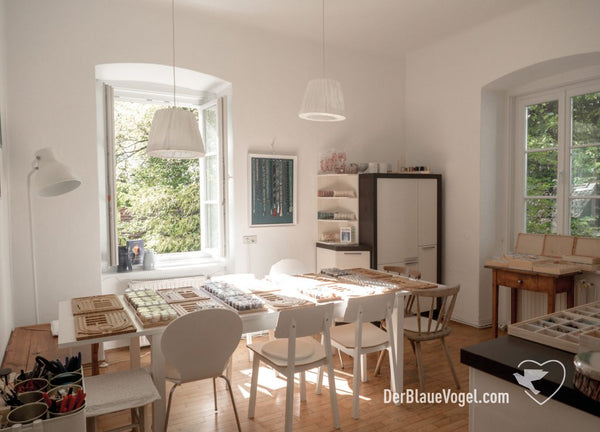
In der gemütlichen Workshop-Küche mitten im Grünen ist ausreichend Platz für 10 Teilnehmer und die riesengroße Auswahl an echten Edelsteinperlen, Natursteinperlen und Zubehör aus echtem Silber, Gold Vermeil, Holz, Glas, Edelstahl und vielen weiteren Materialien.

Über 50 verschiedene ungefärbte Naturstein- und Edelsteinperlen stehen zur Auswahl. Perlen mit 8mm Durchmesser ergeben eine lange, klassische Mala und Perlen mit 6 mm Durchmesser eine kürzere Version, die nicht nur für kleinere Personen ein angenehmes Tragen ermöglichen, ohne die Mala doppelt zu legen.

Eine vielfältige Auswahl an Zwischenperlen bietet unendliche Gestaltungsmöglichkeiten für die ganz persönliche Mala. Diese Markierungen für die Schritte 27, 54 und 81 helfen bei der Japa Meditation dabei, die Orientierung über die bereits erfolgten Wiederholungen zu behalten. Traditionell wurde Alles 108-mal wiederholt, aber heutzutage ist es manchmal schon schwer sich Zeit für 27 Wiederholungen zu nehmen. Eine Steigerung ist auf jeden Fall ein Gewinn.

Traditionell werden Perlenketten auf echter Seide geknüpft. das Material ist natürlich und robust - wenn auch nicht so robust wie Kunstseide oder Nylon - und zudem ein Tierprodukt, was nicht von jedem verwendet werden möchte. Da ich das respektiere und selbst vegan esse, biete ich neben hochwertiger Kunstseide auch Nyloncord und Makramé-Band zum Knüpfen der Malas an. Für die Quasten steht neben Seide auch Baumwolle zur Verfügung.

Nur 3 Minuten vom Ikea Klagenfurt entfernt, im Bezirk Magdalensberg befindet sich in einer alten Volksschule mein wunderschöner Yogaraum. Wer Interesse an der 5-Elemente Yoga Form nach Peter Clifford hat, melde sich bitte gerne!
Kursleitung
Claudia Schleyer ist Architektin, Yogalehrerin und vegane Köchin - und lebt als halbe Kärntnerin in Berlin und Klagenfurt. Im "normalen" Leben berät sie Science Center und Museen zu interaktiven Exponaten und Ausstellungen und engagiert sich in der Makerscene sowie der interaktiven Kunst.

Als halbe Kärntnerin liebe ich es in den Bergen wandern zu gehen. Wenn dann noch das Wetter so ein Traum ist wie hier am Ulrichsberg bzw. Dobratsch, lege ich gerne auch noch eine kleine Yoga-Einheit ein. Am liebsten praktiziere ich dabei die 5-Elemente Form von Peter Clifford, die ich auch unterrichte. Der Vorteil dieser Form ist, dass sie aus stehenden bzw. tanzenden Figuren besteht, die man in jeder Kleidung, an jedem Ort und ohne Yogamatte ausführen kann. Was gibt es Schöneres, als in der Natur zu sein und mit den Elementen zu spielen? Wer dazu mehr erfahren möchte, darf mich gerne ansprechen. Ich unterrichte die Form auch individuell in meinem Yogastudio am Rande von Klagenfurt sowie in der Natur.
Anmeldung und Kursgebühr
Grundgebühr zuzüglich Materialien.
Der Kursbeitrag beträgt 60 € inklusive Getränken und veganen Snacks.
Ebenso enthalten in der Grundgebühr sind Knüpfgarn, Zwischenperlen aus Nickel- und bleifreier Legierung und ein hübscher Schmuckbeutel aus Baumwolle mit "Blume-des Lebens"-Anhänger.
Zusätzlich entstehen Kosten für das individuell verbrauchte Material. Die Mala-Perlen liegen bei 50 Cent/Stück für fast alle Perlen. Höherwertige Perlen und echte Silber bzw. Gold Vermeil Zwischenstücke sowie kleinere Charms und Anhänger liegen zwischen 1€ und 15€ das Stück. Hochwertige Anhänger sind individuell bepreist.
Die Teilnehmerzahl ist auf 6 pro Kurs begrenzt.
Für exklusive Veranstaltungen (Yogaworkshop mit Malakurs, Geburtstags- oder Weihnachtsfeiern, Junggesellinnenabschied, Perlenparty oder ähnlich, bitte ich um kurze Ansprache zur Erstellung eines individuellen Angebotes.
Angebotene Kursmaterialien und Zubehör
Für meine Kurse verwende ich nur hochwertige Materialien und kann meinen Teilnehmern eine große Auswahl davon anbieten.
Zur Auswahl steht unter anderem ein großes Angebot aus:
- Knüpfgarne aus echter hochwertiger Seide
- Vegane Knüpfgarne aus hochwertiger Kunstseide
- Vegane Knüpfgarne aus Nylon
- Vegane Knüpfgarne aus geflochtener Makramé Schnur
- Quastengarne aus hochwertiger Naturseide, Kunstseide oder Baumwolle
- Edelsteinperlen mit 6 und 8 mm Durchmesser
- Halbedelsteinperlen mit 6 und 8 mm Durchmesser
- Holz- und Samenperlen mit 6 und 8 mm Durchmesser
- Marker-Perlen aus 925 er Sterling Silber und Gold Vermeil
- Marker-Perlen aus Zink- und Bleifreiem Thaisilber (Legierung)
- Charms und Anhänger aus aus 925 er Sterling Silber, Gold Vermeil und Edelstahl
- Guruperlen aus Natursteinen, Holz, 925 er Sterling Silber, Gold Vermeil und Edelstahl
- Hochwertige silber gefasste Anhänger aus seltenen Natursteinen als alternative Guruperle für moderne Malas
- Einzigartige von Naturformen abgegossene Bronze-Anhänger von Irene Hiebel
- Einzigartige "Umgarnte Steine" als Anhänger von Melina Kumer
Der Veranstaltungsort
Die Kurse finden in der alten Volksschule von St. Thomas statt. Diese befindet sich ca. 3 Minuten hinter dem Ikea Klagenfurt Richtung Brückl in St. Thomas am Zeiselberg im blauen Haus direkt neben der Kirche oben am Hügel links der Görtschitztaler Landstraße (wenn man von Ikea kommt - ansonsten natürlich rechts.). Mit dem Auto ist sie in ca. 13 Minuten von der Innenstadt Klagenfurts zu erreichen. Bei Bedarf kann auch eine Abholung von der Bushaltestelle am Ikea arrangiert werden. Ein Postbus fährt ebenfalls in größeren Abständen aus der Innenstadt und hält unten an der Bundesstraße - ca. 5 Gehminuten von der Schule entfernt.
Wichtig > Dank einer Adressänderung durch die Gemeinde finden die Navigationssysteme die Adresse eher unter dem alten Namen: St. Thomas 10 (Am Zeiselberg / Magdalensberg / 9064 Pischeldorf)
Die neue offizielle Adresse ist: St. Thomaser Straße 30, 9064 Magdalensberg
Wer sich verfährt wird gerne persönlich telefonisch navigiert unter: +49.173.6033299
Ich freue mich auf das Entstehen vieler neuer Malas! Bei Fragen bitte gerne anrufen oder mailen unter mail(at)derblauevogel.com
Liebe Grüße, Claudia & Der Blaue Vogel
Alle DIY Kurse || Malas | Perlenbretter | Blog











